Launching Lucy
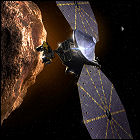 NASA launches the Lucy spacecraft on its twelve-year mission to study select specimens of the Trojan asteroid swarms that both precede and trail the planet Jupiter at the stable LaGrange points in its orbit. Lucy’s complex trajectory calls for it to conduct gravity assist flybys of Earth in 2022 and 2024, and to survey the main asteroid belt body 52246 Donaldjohanson in 2025, en route to reaching its first Trojan asteroid, 3548 Eurybates, in 2027. Future targets include 15094 Polymele later in 2027, 11351 Leucus and 21900 Orus in 2028, and – after a further gravity assist flyby of Earth in 2030 – the binary Trojan pair 617 Patroclus-Menoetius in 2033. Lucy’s name is not an abbreviation; it is named after a famous fossil skeleton discovered in 1971 by a team led by anthropologist David Johanson; it is hoped that studying the Trojan asteroids will lead to discoveries that make them similar “missing links” in the solar system’s own fossil record.
NASA launches the Lucy spacecraft on its twelve-year mission to study select specimens of the Trojan asteroid swarms that both precede and trail the planet Jupiter at the stable LaGrange points in its orbit. Lucy’s complex trajectory calls for it to conduct gravity assist flybys of Earth in 2022 and 2024, and to survey the main asteroid belt body 52246 Donaldjohanson in 2025, en route to reaching its first Trojan asteroid, 3548 Eurybates, in 2027. Future targets include 15094 Polymele later in 2027, 11351 Leucus and 21900 Orus in 2028, and – after a further gravity assist flyby of Earth in 2030 – the binary Trojan pair 617 Patroclus-Menoetius in 2033. Lucy’s name is not an abbreviation; it is named after a famous fossil skeleton discovered in 1971 by a team led by anthropologist David Johanson; it is hoped that studying the Trojan asteroids will lead to discoveries that make them similar “missing links” in the solar system’s own fossil record.
Hayabusa-2’s samples return to Earth
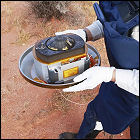 The Japanese space agency, JAXA, successfully recovers the Hayabusa-2 space probe’s sample return container after its return to Earth in Austrailia. The container’s precious cargo is 100 milligrams of surface and subsurface material retrieved by Hayabusa-2 from the surface of asteroid 162173 Ryugu during a series of touch-and-go maneuvers performed between February and July of 2019. Though it drops its samples off during a close flyby of Earth, Hayabusa-2 remains in space, where JAXA hopes to redirect it to study further asteroids, though the probe will no longer have the ability to gather or return samples.
The Japanese space agency, JAXA, successfully recovers the Hayabusa-2 space probe’s sample return container after its return to Earth in Austrailia. The container’s precious cargo is 100 milligrams of surface and subsurface material retrieved by Hayabusa-2 from the surface of asteroid 162173 Ryugu during a series of touch-and-go maneuvers performed between February and July of 2019. Though it drops its samples off during a close flyby of Earth, Hayabusa-2 remains in space, where JAXA hopes to redirect it to study further asteroids, though the probe will no longer have the ability to gather or return samples.
OSIRIS-REx Samples Bennu
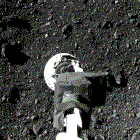 NASA’s OSIRIS-REx robotic spacecraft successfully gathers a generous sample of the surface regolith of asteroid 101955 Bennu on its first attempt, with some of the material estimated to originate from as deep as 49 centimeters beneath Bennu’s surface. (This result indicates that the asteroid’s surface is much softer and more pliable than expected.) The touchdown point was selected in conjunction with volunteer citizen scientists searching for safe places to gather a sample, and ruling out potential touchdown sites that appeared to be too hazardous. Intended to gather a minimum of 60 grams of material from Bennu, OSIRIS-REx is believed to have exceeded that minimum by a wide margin, and approval is given to stow the sample in its return container a week ahead of schedule. OSIRIS-REx will remain in Bennu’s orbit until March 2021, at which time it will fire its engines to begin its journey to return the samples of asteroid matter to Earth in September 2023.
NASA’s OSIRIS-REx robotic spacecraft successfully gathers a generous sample of the surface regolith of asteroid 101955 Bennu on its first attempt, with some of the material estimated to originate from as deep as 49 centimeters beneath Bennu’s surface. (This result indicates that the asteroid’s surface is much softer and more pliable than expected.) The touchdown point was selected in conjunction with volunteer citizen scientists searching for safe places to gather a sample, and ruling out potential touchdown sites that appeared to be too hazardous. Intended to gather a minimum of 60 grams of material from Bennu, OSIRIS-REx is believed to have exceeded that minimum by a wide margin, and approval is given to stow the sample in its return container a week ahead of schedule. OSIRIS-REx will remain in Bennu’s orbit until March 2021, at which time it will fire its engines to begin its journey to return the samples of asteroid matter to Earth in September 2023.
Hayabusa-2 now departing Ryugu
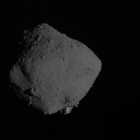 Japan’s Hayabusa-2 uncrewed spacecraft, carrying samples of material from asteroid 162173 Ryugu, begins its long trip home after spending nearly a year and a half in Ryugu’s orbit, where it deposited autonomous robotic landers and fired a projectile into Ryugu’s surface to loosen material for capture and return to Earth. First launched in 2014, Hayabusa-2’s return trajectory to Earth is expected to bring the samples of asteroid material home to a safe landing in Australia in late 2020.
Japan’s Hayabusa-2 uncrewed spacecraft, carrying samples of material from asteroid 162173 Ryugu, begins its long trip home after spending nearly a year and a half in Ryugu’s orbit, where it deposited autonomous robotic landers and fired a projectile into Ryugu’s surface to loosen material for capture and return to Earth. First launched in 2014, Hayabusa-2’s return trajectory to Earth is expected to bring the samples of asteroid material home to a safe landing in Australia in late 2020.
New Horizons explores 2014 MU69
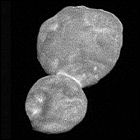 NASA’s New Horizons space probe, operated by Johns Hopkins University’s Applied Physics Lab, passes within 2,200 miles of the mysterious Kuiper Belt object 2014 MU69, a tiny fragment of leftover material from the birth of the solar system. Previously seen only as a tiny pixel even by the powerful lens of the Hubble Space Telescope, nothing was known of 2014 MU69 prior to the flyby, which revealed it as a contact binary: two bodies which had become gravitationally fused together. As 2014 MU69 (informally nicknamed Ultima Thule in a public poll conducted by the New Horizons public outreach team) is a billion miles further away than Pluto, and with New Horizons continuing outward at 30,000 miles per hour, signals between Earth and New Horizons take at least six hours to reach their destination, so the downlink of data from the flyby would take until 2020 to complete.
NASA’s New Horizons space probe, operated by Johns Hopkins University’s Applied Physics Lab, passes within 2,200 miles of the mysterious Kuiper Belt object 2014 MU69, a tiny fragment of leftover material from the birth of the solar system. Previously seen only as a tiny pixel even by the powerful lens of the Hubble Space Telescope, nothing was known of 2014 MU69 prior to the flyby, which revealed it as a contact binary: two bodies which had become gravitationally fused together. As 2014 MU69 (informally nicknamed Ultima Thule in a public poll conducted by the New Horizons public outreach team) is a billion miles further away than Pluto, and with New Horizons continuing outward at 30,000 miles per hour, signals between Earth and New Horizons take at least six hours to reach their destination, so the downlink of data from the flyby would take until 2020 to complete.
OSIRIS-REx
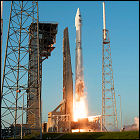 NASA launches the unmanned OSIRIS-REx (Origins Spectral Interpretation Resource Identification Security Regolith Explorer) spacecraft, bound for the asteroid Bennu, a target it won’t reach for two years. Once at Bennu, OSIRIS-REx is intended to orbit the asteroid and then drop down close enough to gather surface samples for return to Earth in a small sample container capable of surviving re-entry through the atmosphere. The samples from Bennu, an asteroid considered a hazard for Earth in the future, will not arrive until September 2023.
NASA launches the unmanned OSIRIS-REx (Origins Spectral Interpretation Resource Identification Security Regolith Explorer) spacecraft, bound for the asteroid Bennu, a target it won’t reach for two years. Once at Bennu, OSIRIS-REx is intended to orbit the asteroid and then drop down close enough to gather surface samples for return to Earth in a small sample container capable of surviving re-entry through the atmosphere. The samples from Bennu, an asteroid considered a hazard for Earth in the future, will not arrive until September 2023.
Dawn arrives at Ceres
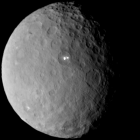 The unmanned NASA/JPL space probe Dawn arrives at its second and final destination, the dwarf planet Ceres, a body which dominates the asteroid belt between Mars and Jupiter. Beginning to bring itself into a closer mapping orbit around Ceres, Dawn has already spotted unusually bright surface features, drawing early speculation from scientists that the highly reflective points on Ceres may be indicative of ice formations or cryovolcanism. Though its main engine is powered by charged ions, Dawn is scheduled to remain at Ceres for as long as its chemical propellant supply holds, powering smaller traditional rockets needed for attitude control.
The unmanned NASA/JPL space probe Dawn arrives at its second and final destination, the dwarf planet Ceres, a body which dominates the asteroid belt between Mars and Jupiter. Beginning to bring itself into a closer mapping orbit around Ceres, Dawn has already spotted unusually bright surface features, drawing early speculation from scientists that the highly reflective points on Ceres may be indicative of ice formations or cryovolcanism. Though its main engine is powered by charged ions, Dawn is scheduled to remain at Ceres for as long as its chemical propellant supply holds, powering smaller traditional rockets needed for attitude control.
Dawn: first in a Ceres
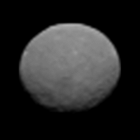 The unmanned NASA spacecraft Dawn transmits a series of pictures of Ceres, the minor planet which is the largest known object in the main asteroid belt between Mars and Jupiter, back to Earth, representing the best view yet of an object which had been seen as little more than a point of light since its discovery in 1801. From a distance of only 147,000 miles, Dawn is able to see more detail on Ceres than the best Hubble Space Telescope images of the same body. Dawn will arrive at Ceres and use its ion propulsion system to enter its orbit in March 2015.
The unmanned NASA spacecraft Dawn transmits a series of pictures of Ceres, the minor planet which is the largest known object in the main asteroid belt between Mars and Jupiter, back to Earth, representing the best view yet of an object which had been seen as little more than a point of light since its discovery in 1801. From a distance of only 147,000 miles, Dawn is able to see more detail on Ceres than the best Hubble Space Telescope images of the same body. Dawn will arrive at Ceres and use its ion propulsion system to enter its orbit in March 2015.
Hayabusa 2: back to the asteroid belt
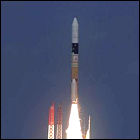 The Japanese Aerospace Exploration Agency (JAXA) launches the Hayabusa-2 unmanned space probe, intended to study and sample asteroid 162173 Ryugu in 2018. Mission plans call for the ion-engine-powered Hayabusa-2 to remain at Ryugu for a year before returning to Earth with its sample. Hayabusa-2 also carries a European-built lander and an explosive penetrator to expose the asteroid’s subsurface material (using the same principle as the Deep Impact mission to Comet Tempel 1 in 2005.
The Japanese Aerospace Exploration Agency (JAXA) launches the Hayabusa-2 unmanned space probe, intended to study and sample asteroid 162173 Ryugu in 2018. Mission plans call for the ion-engine-powered Hayabusa-2 to remain at Ryugu for a year before returning to Earth with its sample. Hayabusa-2 also carries a European-built lander and an explosive penetrator to expose the asteroid’s subsurface material (using the same principle as the Deep Impact mission to Comet Tempel 1 in 2005.
2012 DA14’s close shave
 One of the closest asteroid encounters since the beginning of intensive asteroid tracking, asteroid 2012 DA14 swings past Earth at a distance of only 17,200 miles – putting it closer to Earth than most weather and communcations satellites in geosynchronous orbit. Despite this, the asteroid is well outside the orbit of such low-Earth-orbit structures as the International Space Station. Discovered in February 2012, 2012 DA14 has a diameter of approximately 150 feet and is moving at a speed of over 17,000 miles per hour. 2012 DA14’s next closest approach will take place in 2046, but it will not make another passage this close until 2110. The asteroid is unrelated to a meteor airburst event earlier the same day over Russia.
One of the closest asteroid encounters since the beginning of intensive asteroid tracking, asteroid 2012 DA14 swings past Earth at a distance of only 17,200 miles – putting it closer to Earth than most weather and communcations satellites in geosynchronous orbit. Despite this, the asteroid is well outside the orbit of such low-Earth-orbit structures as the International Space Station. Discovered in February 2012, 2012 DA14 has a diameter of approximately 150 feet and is moving at a speed of over 17,000 miles per hour. 2012 DA14’s next closest approach will take place in 2046, but it will not make another passage this close until 2110. The asteroid is unrelated to a meteor airburst event earlier the same day over Russia.
Chang’e 2 scans an asteroid
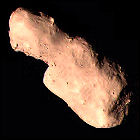 Originally launched by China to orbit the moon in 2010, and later parked at a LaGrange point beyond the moon’s orbit, the unmanned Chang’e 2 space probe flies by asteroid 4179 Toutatis at a distance of under two miles, capturing the first close-up images of the asteroid as it passes Earth almost half a million miles away. Though 4179 Toutatis has been imaged by ground-based radar on several occasions during its semi-frequent visits to the inner solar system, this is the first space probe to visit it at close range. As of this encounter, Chang’e 2 is the most distant Chinese spacecraft from Earth.
Originally launched by China to orbit the moon in 2010, and later parked at a LaGrange point beyond the moon’s orbit, the unmanned Chang’e 2 space probe flies by asteroid 4179 Toutatis at a distance of under two miles, capturing the first close-up images of the asteroid as it passes Earth almost half a million miles away. Though 4179 Toutatis has been imaged by ground-based radar on several occasions during its semi-frequent visits to the inner solar system, this is the first space probe to visit it at close range. As of this encounter, Chang’e 2 is the most distant Chinese spacecraft from Earth.
Dawn departs Vesta
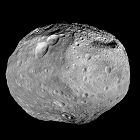 NASA’s Dawn unmanned space probe fires up its ion propulsion system, breaking its orbit around the large asteroid Vesta. Having orbited and mapped Vesta since 2011, Dawn must now survive a nearly-three-year trip through the main asteroid belt to reach the largest body in that region, Ceres. Successful arrival at Ceres, planned for 2015, would make Dawn the first unmanned spacecraft to have orbited two bodies in the solar system.
NASA’s Dawn unmanned space probe fires up its ion propulsion system, breaking its orbit around the large asteroid Vesta. Having orbited and mapped Vesta since 2011, Dawn must now survive a nearly-three-year trip through the main asteroid belt to reach the largest body in that region, Ceres. Successful arrival at Ceres, planned for 2015, would make Dawn the first unmanned spacecraft to have orbited two bodies in the solar system.
Dawn: getting closer to Vesta
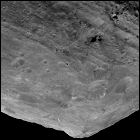 NASA’s unmanned Dawn spacecraft, having completed its high-altitude mapping of the asteroid Vesta, drops to a lower altitude for more detailed mapping of Vesta’s surface. On average, its new orbit will allow Dawn to circle Vesta at an altitude of 130 miles, down from its previous 430-mile-high altitude. Dawn is imaging Vesta stereographically, allowing for precise measurements of surface features and the asteroid’s overall shape. In 2012, Dawn is scheduled to fire its ion thruster again, breaking orbit and leaving Vesta for a three-year cruise to the largest body in the asteroid belt, Ceres, arriving in 2015.
NASA’s unmanned Dawn spacecraft, having completed its high-altitude mapping of the asteroid Vesta, drops to a lower altitude for more detailed mapping of Vesta’s surface. On average, its new orbit will allow Dawn to circle Vesta at an altitude of 130 miles, down from its previous 430-mile-high altitude. Dawn is imaging Vesta stereographically, allowing for precise measurements of surface features and the asteroid’s overall shape. In 2012, Dawn is scheduled to fire its ion thruster again, breaking orbit and leaving Vesta for a three-year cruise to the largest body in the asteroid belt, Ceres, arriving in 2015.
Dawn orbits Vesta
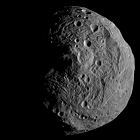 Launched in 2007, NASA’s unmanned space probe Dawn enters orbit of Vesta, one of the largest bodies in the main asteroid belt between Mars and Jupiter. Over time, the mission plan calls for Dawn to spiral down to lower orbits to explore and map Vesta from orbit, trying to determine what secrets the large asteroid has about the earliest days of the solar system. If all goes well, Dawn will remain at Vesta until 2012, and will depart to explore another asteroid, Ceres, arriving there in 2015.
Launched in 2007, NASA’s unmanned space probe Dawn enters orbit of Vesta, one of the largest bodies in the main asteroid belt between Mars and Jupiter. Over time, the mission plan calls for Dawn to spiral down to lower orbits to explore and map Vesta from orbit, trying to determine what secrets the large asteroid has about the earliest days of the solar system. If all goes well, Dawn will remain at Vesta until 2012, and will depart to explore another asteroid, Ceres, arriving there in 2015.
Dawn and the vistas of Vesta
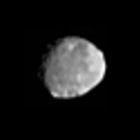 From a distance of 117,000 miles, NASA’s Dawn unmanned space probe captures the best picture yet of the asteroid Vesta, one of the two largest bodies in the solar system’s main asteroid belt between Mars and Jupiter. Launched in 2007, Dawn is scheduled to orbit and map Vesta before moving on to the asteroid belt’s largest resident, Ceres, in 2015. Mission scientists hope that the two asteroids – remnants of what may be an unformed or destroyed rocky planet beyond Mars’ orbit – will yield clues about the formation of the solar system.
From a distance of 117,000 miles, NASA’s Dawn unmanned space probe captures the best picture yet of the asteroid Vesta, one of the two largest bodies in the solar system’s main asteroid belt between Mars and Jupiter. Launched in 2007, Dawn is scheduled to orbit and map Vesta before moving on to the asteroid belt’s largest resident, Ceres, in 2015. Mission scientists hope that the two asteroids – remnants of what may be an unformed or destroyed rocky planet beyond Mars’ orbit – will yield clues about the formation of the solar system.
Hayabusa comes home
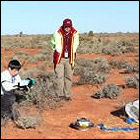 Japan’s Hayabusa unmanned space probe releases a re-entry capsule containing samples of surface material it gathered from asteroid 25143 Itokawa in 2005. The capsule survives a punishing 25G re-entry and is recovered from the Australian outback, as planned, while Hayabusa itself burns up in Earth’s atmosphere. The sample payload – approximately 1500 grains averaging 10 micrometers in diameter – reveals that Itokawa has a composition virtually identical to a chondrite meteorite. A significant achievement in the history of the Japanese space program, the Hayabusa mission inspires no fewer than three movies, and a sequel of its own: the Hayabusa-2 space probe, approved in August 2010 and scheduled for launch in 2014.
Japan’s Hayabusa unmanned space probe releases a re-entry capsule containing samples of surface material it gathered from asteroid 25143 Itokawa in 2005. The capsule survives a punishing 25G re-entry and is recovered from the Australian outback, as planned, while Hayabusa itself burns up in Earth’s atmosphere. The sample payload – approximately 1500 grains averaging 10 micrometers in diameter – reveals that Itokawa has a composition virtually identical to a chondrite meteorite. A significant achievement in the history of the Japanese space program, the Hayabusa mission inspires no fewer than three movies, and a sequel of its own: the Hayabusa-2 space probe, approved in August 2010 and scheduled for launch in 2014.
Mars in asteroid’s crosshairs
 Astronomers put the red planet on red alert after predicting 1-in-75 odds for an asteroid to collide with Mars on or near January 30th. The asteroid, discovered in November 2007, is on a trajectory that poses no threat to Earth but has better-than-usual odds of packing quite a wallop for Mars. The impact, if it does happen, could take place on the equator, near the Opportunity rover’s stomping (or, perhaps, roving) grounds, though NASA says it would pose no risk to Opportunity. A crater as large as Arizona’s Meteor Crater could be carved out of the Martian surface by any direct hit that does happen. Scientists prepare to watch the event with keen interest, as this event would be potentially cataclysmic if Earth was in danger, but provides a once-in-a-lifetime opportunity for observation on Mars.
Astronomers put the red planet on red alert after predicting 1-in-75 odds for an asteroid to collide with Mars on or near January 30th. The asteroid, discovered in November 2007, is on a trajectory that poses no threat to Earth but has better-than-usual odds of packing quite a wallop for Mars. The impact, if it does happen, could take place on the equator, near the Opportunity rover’s stomping (or, perhaps, roving) grounds, though NASA says it would pose no risk to Opportunity. A crater as large as Arizona’s Meteor Crater could be carved out of the Martian surface by any direct hit that does happen. Scientists prepare to watch the event with keen interest, as this event would be potentially cataclysmic if Earth was in danger, but provides a once-in-a-lifetime opportunity for observation on Mars.
Asteroid explorer Dawn lifts off
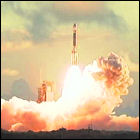 NASA launches the unmanned Dawn spacecraft, a vehicle designed to explore the two largest bodies in the asteroid belt between Mars and Jupiter. Dawn will also test a new charged ion propulsion system designed to improve on the performance of traditional chemical propellants (though its fine-tuning reaction control system will still use small engines powered by “rocket fuel”). Dawn is intended to visit and orbit the asteroid Vesta in 2011, which it will then depart after mapping to explore Ceres in 2015.
NASA launches the unmanned Dawn spacecraft, a vehicle designed to explore the two largest bodies in the asteroid belt between Mars and Jupiter. Dawn will also test a new charged ion propulsion system designed to improve on the performance of traditional chemical propellants (though its fine-tuning reaction control system will still use small engines powered by “rocket fuel”). Dawn is intended to visit and orbit the asteroid Vesta in 2011, which it will then depart after mapping to explore Ceres in 2015.
NASA rethinks Dawn cancellation
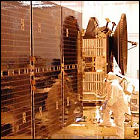 NASA reverses a decision made earlier in the month to cancel the asteroid-hopping Dawn mission, following appeals and assurances from the mission managers. Intended to use ion propulsion to visit to of the asteroid belt’s largest bodies, Dawn’s cancellation does have the effect of sliding the mission from a 2006 launch to a 2007 launch. The budget for the mission is expanded from $373,000,000 to $446,000,000, and arrival at its first target, the large asteroid Vesta, is still scheduled for 2011.
NASA reverses a decision made earlier in the month to cancel the asteroid-hopping Dawn mission, following appeals and assurances from the mission managers. Intended to use ion propulsion to visit to of the asteroid belt’s largest bodies, Dawn’s cancellation does have the effect of sliding the mission from a 2006 launch to a 2007 launch. The budget for the mission is expanded from $373,000,000 to $446,000,000, and arrival at its first target, the large asteroid Vesta, is still scheduled for 2011.
NASA’s Dawn mission cancelled
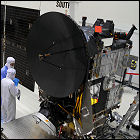 Having been “on hold” since October 2005 pending an audit of technical and managerial issues related to the mission, NASA formally cancels the Dawn unmanned mission to the asteroid belt. The spacecraft had been intended to lift off in 2006, using an ion propulsion system to visit, orbit, and map not one, but two, of the largest bodies in the asteroid belt between Mars and Jupiter, in the following decade. The mission is cancelled when NASA auditors find unresolved technical issues and project a budget overrun of 20%. Planners and managers for the Dawn mission plan to appeal NASA’s decision.
Having been “on hold” since October 2005 pending an audit of technical and managerial issues related to the mission, NASA formally cancels the Dawn unmanned mission to the asteroid belt. The spacecraft had been intended to lift off in 2006, using an ion propulsion system to visit, orbit, and map not one, but two, of the largest bodies in the asteroid belt between Mars and Jupiter, in the following decade. The mission is cancelled when NASA auditors find unresolved technical issues and project a budget overrun of 20%. Planners and managers for the Dawn mission plan to appeal NASA’s decision.
Homeward, Hayabusa!
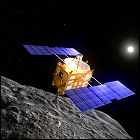 JAXA’s unmanned Hayabusa spacecraft fires its ion engines to depart asteroid 25143 Itokawa, embarking on a five-year trek back to Earth to return surface samples it obtained of the asteroid. Hayabusa has experienced numerous technical glitches, and continues to experience further problems, including a total loss of contact with Earth for several weeks. Only two out of the vehicle’s four ion engines are still functional, and its battery system is only partially reliable, but it is carrying its precious cargo of the first sample material from an asteroid back to Earth.
JAXA’s unmanned Hayabusa spacecraft fires its ion engines to depart asteroid 25143 Itokawa, embarking on a five-year trek back to Earth to return surface samples it obtained of the asteroid. Hayabusa has experienced numerous technical glitches, and continues to experience further problems, including a total loss of contact with Earth for several weeks. Only two out of the vehicle’s four ion engines are still functional, and its battery system is only partially reliable, but it is carrying its precious cargo of the first sample material from an asteroid back to Earth.
Hayabusa on Itokawa
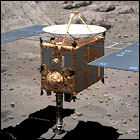 A second attempt is made by the Japanese Aerospace Exploration Agency to bring its unmanned space probe, Hayabusa, close enough to gather a sample of surface material from asteroid 25143 Itokawa. It attempts to deploy a mini-rover called Minerva to explore Itokawa from the surface, but a glitch results in a trajectory that leaves Minerva tumbling into space, never to reach Itokawa. Hayabusa lands on Itokawa’s surface itself, though mission controllers don’t realize this for several more days. Contact is lost with Hayabusa for a short while, and when it is regained, the vehicle has left the surface and gone into safe mode.
A second attempt is made by the Japanese Aerospace Exploration Agency to bring its unmanned space probe, Hayabusa, close enough to gather a sample of surface material from asteroid 25143 Itokawa. It attempts to deploy a mini-rover called Minerva to explore Itokawa from the surface, but a glitch results in a trajectory that leaves Minerva tumbling into space, never to reach Itokawa. Hayabusa lands on Itokawa’s surface itself, though mission controllers don’t realize this for several more days. Contact is lost with Hayabusa for a short while, and when it is regained, the vehicle has left the surface and gone into safe mode.
Hayabusa pulls up
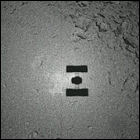 The first attempt to maneuver the unmanned space probe Hayabusa close enough to scoop up a sample of material from the surface of asteroid 25143 Itokawa is aborted by ground controllers at the Japanese space agency, JAXA. The spacecraft’s navigational system finds it difficult to maintain a precise lock on the elongated asteroid, so its automatic safety systems abort the approach to preserve Hayabusa intact. Another attempt to bring Hayabusa close enough to gather material from Itokawa’s surface will be made a week later.
The first attempt to maneuver the unmanned space probe Hayabusa close enough to scoop up a sample of material from the surface of asteroid 25143 Itokawa is aborted by ground controllers at the Japanese space agency, JAXA. The spacecraft’s navigational system finds it difficult to maintain a precise lock on the elongated asteroid, so its automatic safety systems abort the approach to preserve Hayabusa intact. Another attempt to bring Hayabusa close enough to gather material from Itokawa’s surface will be made a week later.
Hayabusa at Itokawa
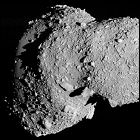 The Japanese unmanned space probe Hayabusa arrives at its destination, asteroid 25143 Itokawa, from which it will gather a sample of material for return to Earth and attempt to deploy a mini-rover. Hayabusa settles into an orbit around the sun parallel to Itokawa, rather than orbiting the asteroid itself, and maintains an initial distance of roughly 12 miles.
The Japanese unmanned space probe Hayabusa arrives at its destination, asteroid 25143 Itokawa, from which it will gather a sample of material for return to Earth and attempt to deploy a mini-rover. Hayabusa settles into an orbit around the sun parallel to Itokawa, rather than orbiting the asteroid itself, and maintains an initial distance of roughly 12 miles.
Hayabusa!
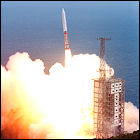 Japan’s Institute of Space and Astronautical Science (ISAS), launches the unmanned Hayabusa space probe on a mission to gather material from asteroid 25143 Itokawa. Intended to reach Itokawa in two years, and then return the asteroid samples to Earth in 2010, Hayabusa will also attempt to drop a small rover on Itokawa’s surface and will test an ion engine propulsion system. The name “Hayabusa” – translating to “peregrine falcon” – is only bestowed upon the spacecraft once it reaches space; prior to that, Hayabusa is known by its engineering designation, MUSES-C. A few months after Hayabusa’s launch, ISAS itself is renamed JAXA (the Japanese Aerospace Exploration Agency).
Japan’s Institute of Space and Astronautical Science (ISAS), launches the unmanned Hayabusa space probe on a mission to gather material from asteroid 25143 Itokawa. Intended to reach Itokawa in two years, and then return the asteroid samples to Earth in 2010, Hayabusa will also attempt to drop a small rover on Itokawa’s surface and will test an ion engine propulsion system. The name “Hayabusa” – translating to “peregrine falcon” – is only bestowed upon the spacecraft once it reaches space; prior to that, Hayabusa is known by its engineering designation, MUSES-C. A few months after Hayabusa’s launch, ISAS itself is renamed JAXA (the Japanese Aerospace Exploration Agency).
NEAR-Shoemaker signing off
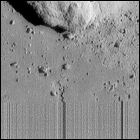 NASA’s NEAR-Shoemaker unmanned spacecraft, still on the surface of asteroid 433 Eros, sends its final signals to Earth before shutting down. Launched in 1996, NEAR-Shoemaker swung by asteroid 253 Mathilde before making its way to Eros via an Earth gravity assist maneuver. It orbited Eros for a year, having started its operations in close proximity to the asteroid a year later due to a technical problem in 1998 that nearly destroyed the space probe. Future asteroid missions such as Hayabusa and Dawn will refine the science of traveling to and studying asteroids.
NASA’s NEAR-Shoemaker unmanned spacecraft, still on the surface of asteroid 433 Eros, sends its final signals to Earth before shutting down. Launched in 1996, NEAR-Shoemaker swung by asteroid 253 Mathilde before making its way to Eros via an Earth gravity assist maneuver. It orbited Eros for a year, having started its operations in close proximity to the asteroid a year later due to a technical problem in 1998 that nearly destroyed the space probe. Future asteroid missions such as Hayabusa and Dawn will refine the science of traveling to and studying asteroids.
NEAR-Shoemaker lands on Eros
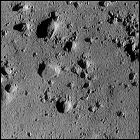 NASA’s NEAR-Shoemaker unmanned spacecraft gently touches down on the surface of asteroid 433 Eros, the first human-made space vehicle to land on such a body. Ground controllers are surprised to discover that NEAR-Shoemaker survives the landing, which was originally meant to end the mission; a two-week mission extension allows scientists to get readings from instruments that are now mere inches from Eros’ surface.
NASA’s NEAR-Shoemaker unmanned spacecraft gently touches down on the surface of asteroid 433 Eros, the first human-made space vehicle to land on such a body. Ground controllers are surprised to discover that NEAR-Shoemaker survives the landing, which was originally meant to end the mission; a two-week mission extension allows scientists to get readings from instruments that are now mere inches from Eros’ surface.
NEAR gets a new name
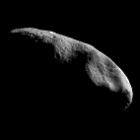 NASA’s NEAR (Near Earth Asteroid Rendezvous) unmanned spacecraft is officially renamed NEAR-Shoemaker, honoring Eugene Shoemaker, discoverer of multiple asteroids and comets, who died in 1997. Shoemaker had also put his geology skills to use in training Apollo astronauts after a medical diagnosis prevented him from joining the astronaut corps himself. NEAR-Shoemaker continues to orbit asteroid 433 Eros.
NASA’s NEAR (Near Earth Asteroid Rendezvous) unmanned spacecraft is officially renamed NEAR-Shoemaker, honoring Eugene Shoemaker, discoverer of multiple asteroids and comets, who died in 1997. Shoemaker had also put his geology skills to use in training Apollo astronauts after a medical diagnosis prevented him from joining the astronaut corps himself. NEAR-Shoemaker continues to orbit asteroid 433 Eros.
NEARer to Eros
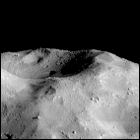 After orbiting the sun behind asteroid 433 Eros for a year since a failed thruster burn almost ended its mission, unmanned space probe NEAR (Near Earth Asteroid Rendezvous) fires its engines successfully, slowing itself to fall into orbit around Eros. During the weeks leading up to the orbital insertion maneuver, NEAR observed the space around Eros to ensure that no satellites existed with which it might collide. NEAR’s close study of Eros officially begins, and further maneuvers bring it into an ever-closer orbit around the asteroid.
After orbiting the sun behind asteroid 433 Eros for a year since a failed thruster burn almost ended its mission, unmanned space probe NEAR (Near Earth Asteroid Rendezvous) fires its engines successfully, slowing itself to fall into orbit around Eros. During the weeks leading up to the orbital insertion maneuver, NEAR observed the space around Eros to ensure that no satellites existed with which it might collide. NEAR’s close study of Eros officially begins, and further maneuvers bring it into an ever-closer orbit around the asteroid.
NEAR death experience?
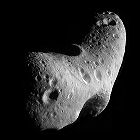 NASA’s unmanned NEAR (Near Earth Asteroid Rendezvous) unmanned space probe fails to fire its thrusters for a critical engine burn to keep it aimed at asteroid 433 Eros. The vehicle instead goes into an automatic safe mode and enters a tumble that drains both its batteries and its fuel supply to dangerously low levels, and it is out of contact with Earth for over a day. As a result, NEAR merely flies past Eros at a distance of almost 2400 miles, leaving ground controllers to devise a strategy to re-aim NEAR so it can catch up to and try once again to orbit the asteroid (the primary objective of its mission). This maneuver will take a year to complete.
NASA’s unmanned NEAR (Near Earth Asteroid Rendezvous) unmanned space probe fails to fire its thrusters for a critical engine burn to keep it aimed at asteroid 433 Eros. The vehicle instead goes into an automatic safe mode and enters a tumble that drains both its batteries and its fuel supply to dangerously low levels, and it is out of contact with Earth for over a day. As a result, NEAR merely flies past Eros at a distance of almost 2400 miles, leaving ground controllers to devise a strategy to re-aim NEAR so it can catch up to and try once again to orbit the asteroid (the primary objective of its mission). This maneuver will take a year to complete.